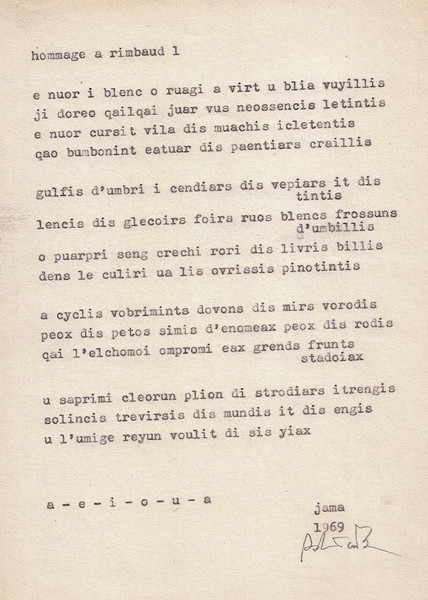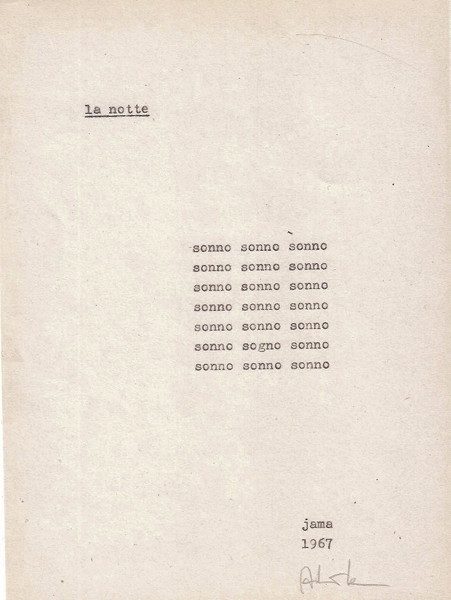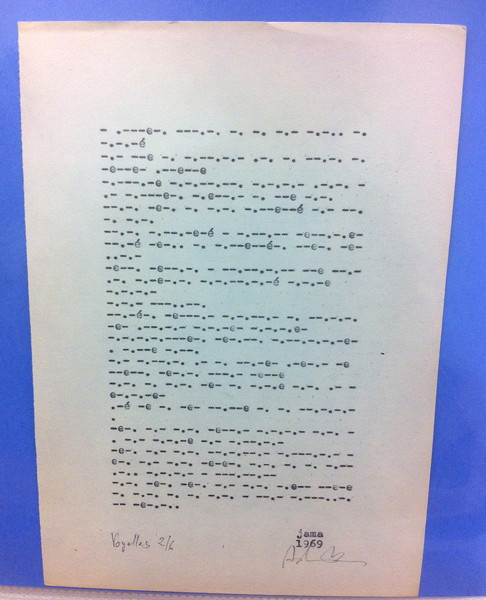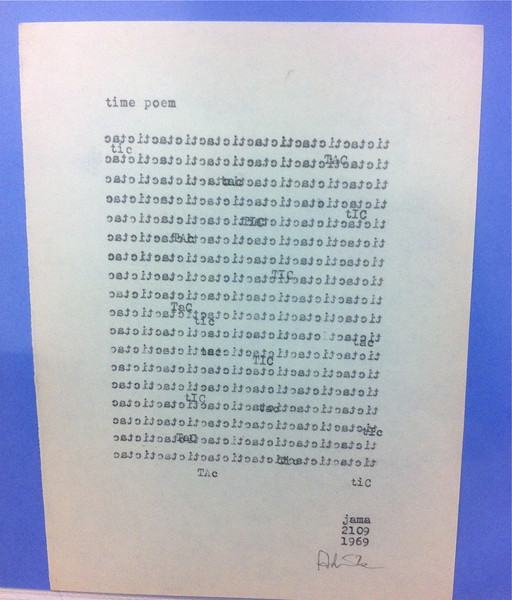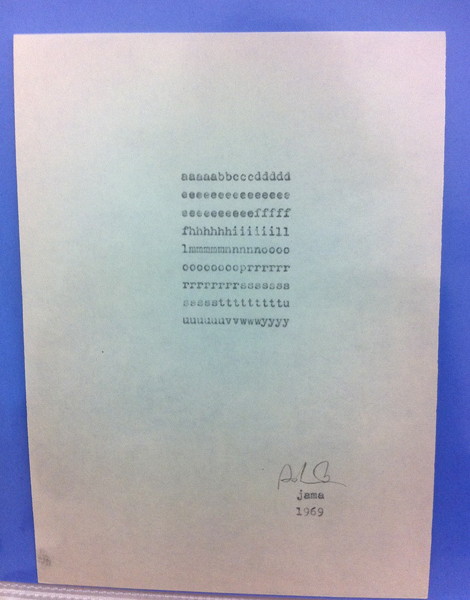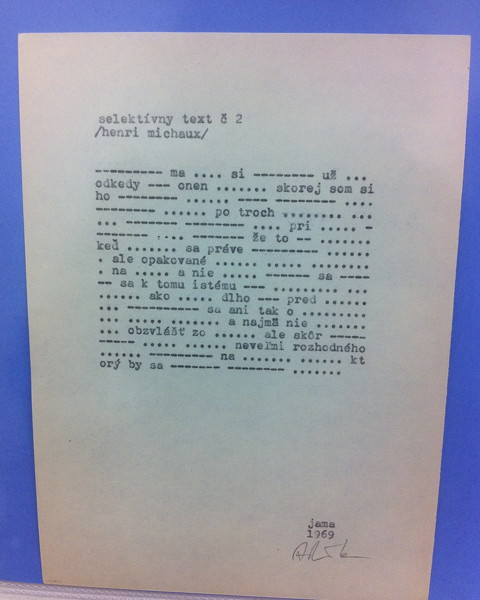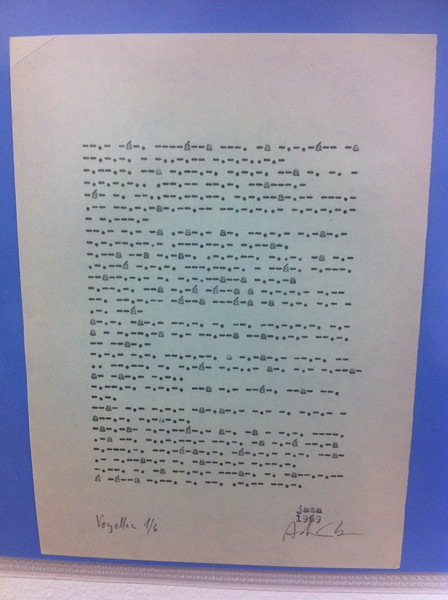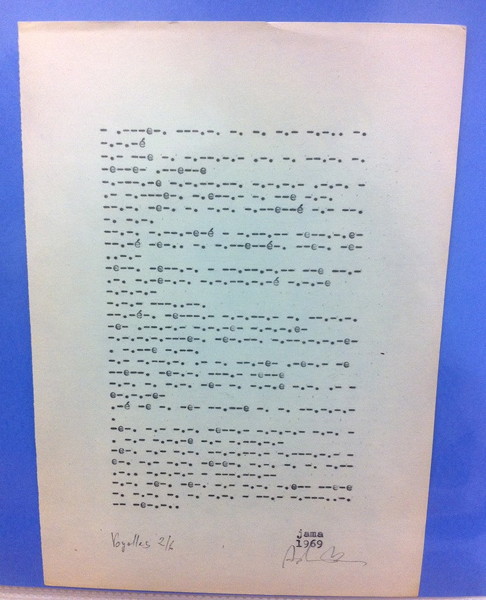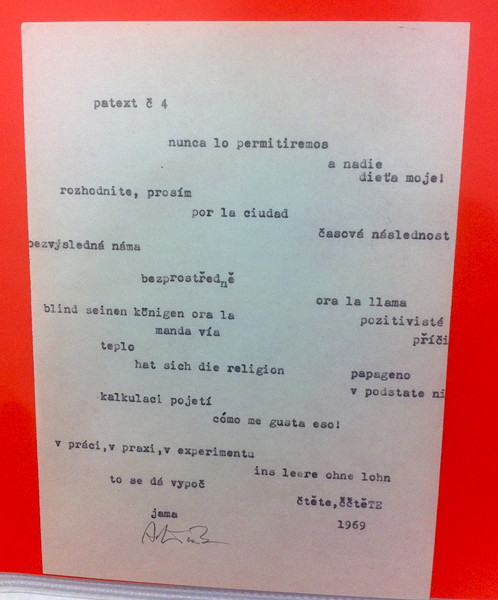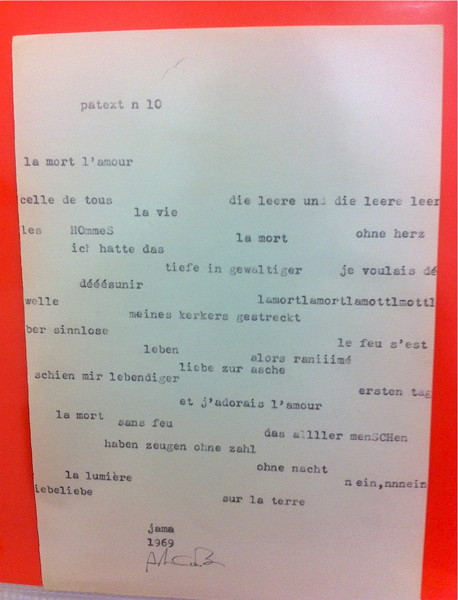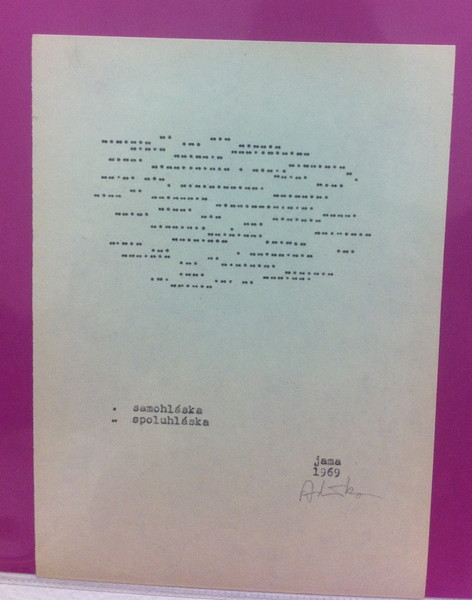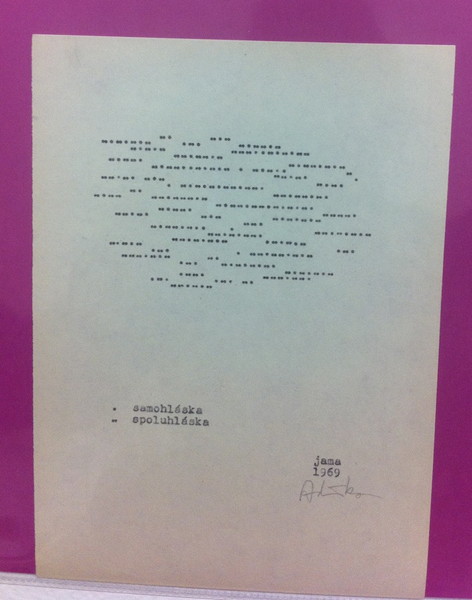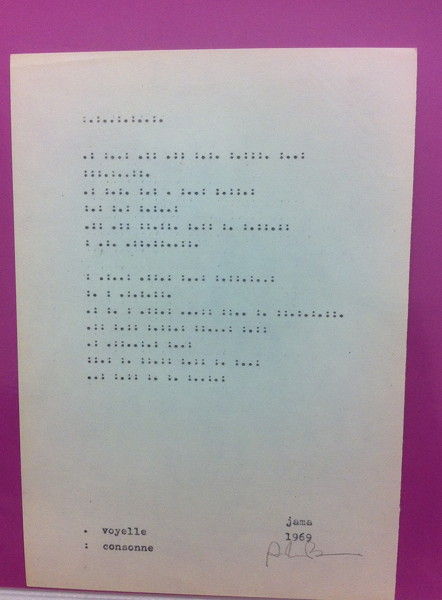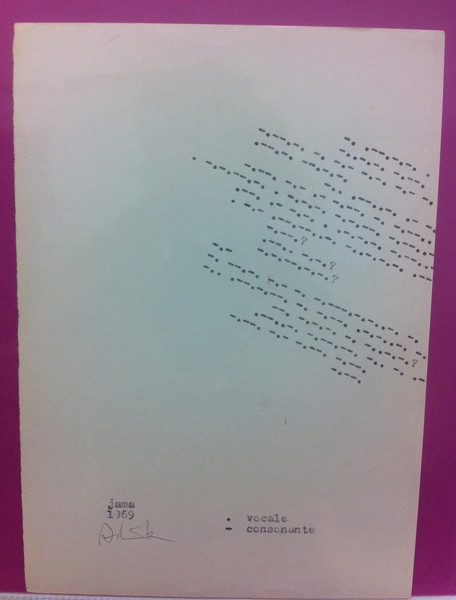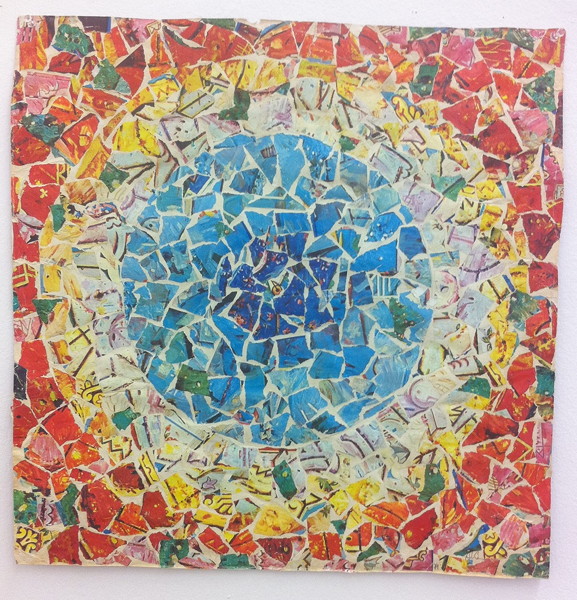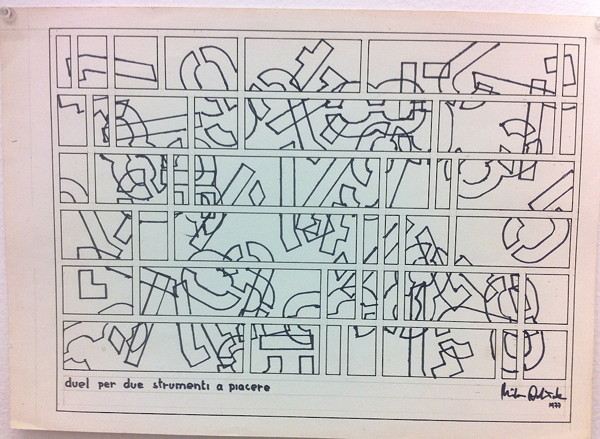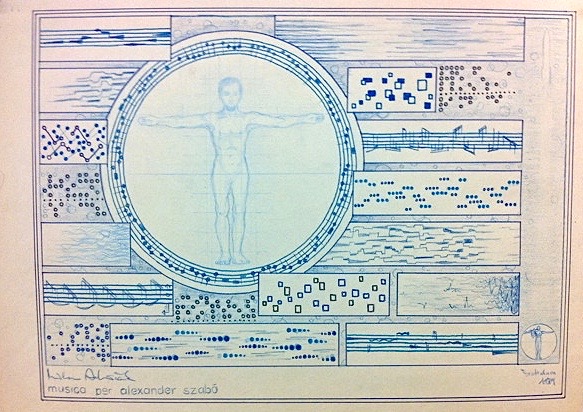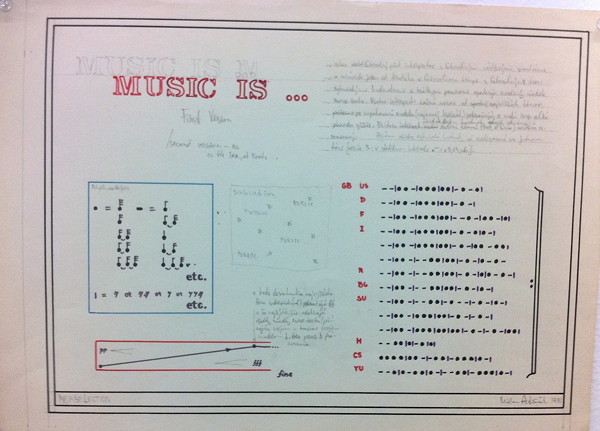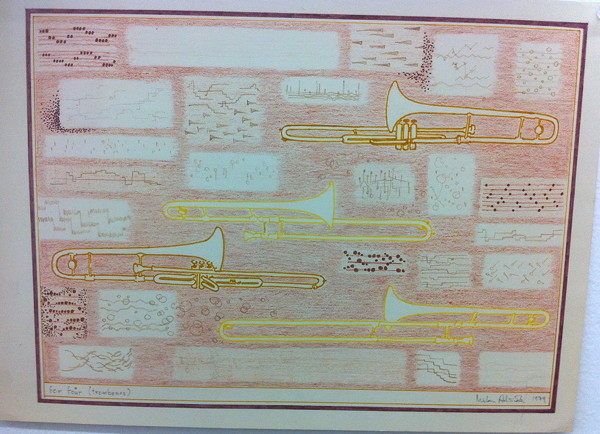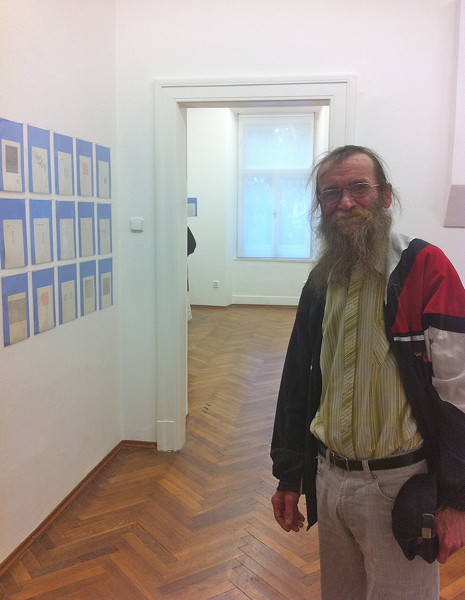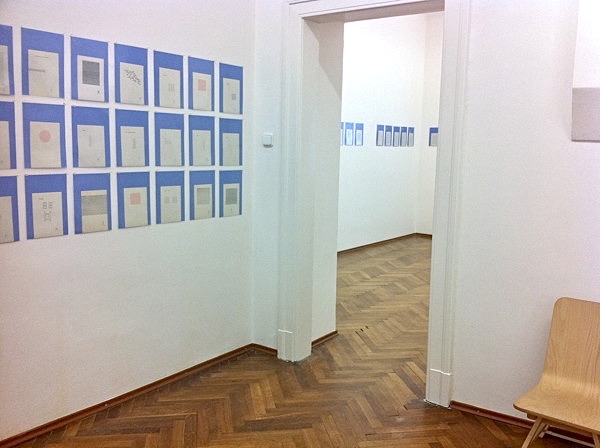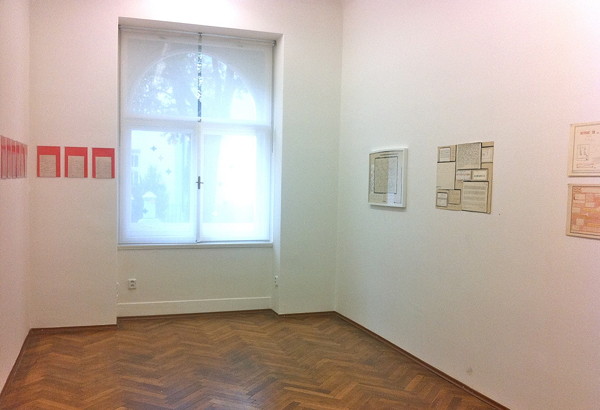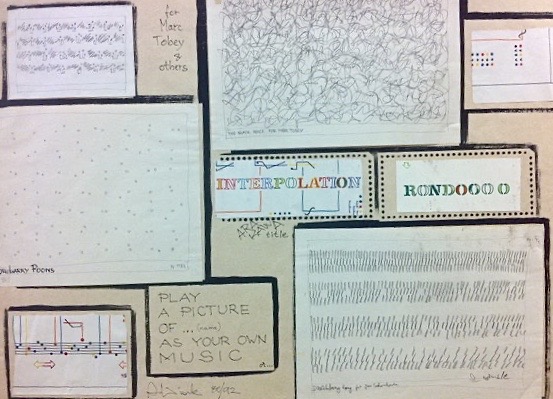Milan Adamčiak
Bratislava
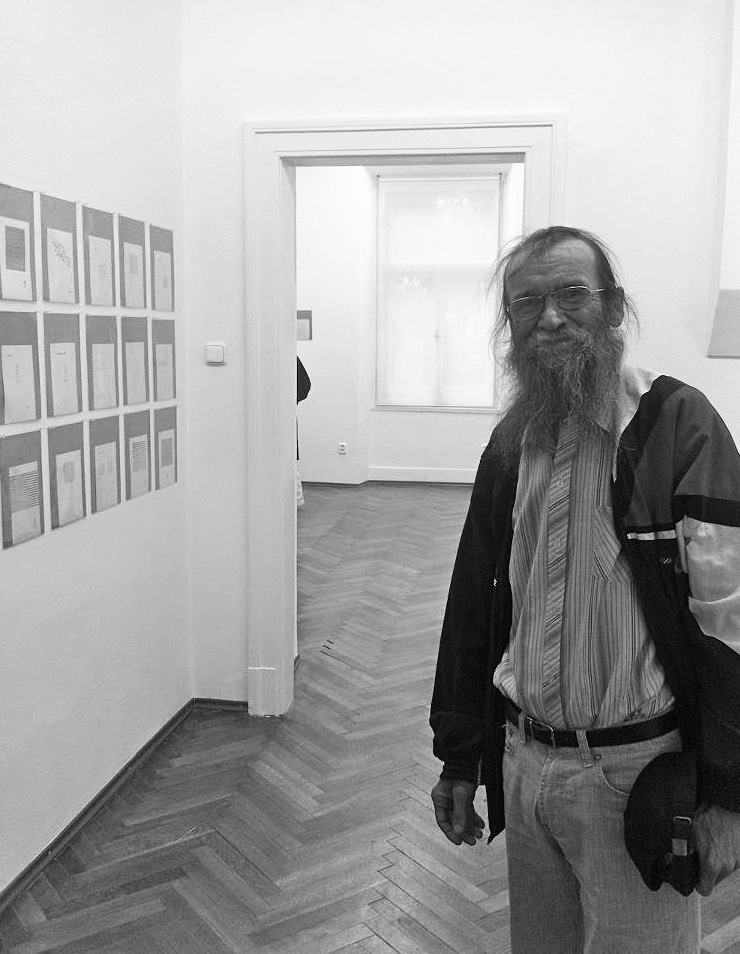
EX-PO
Exhibition: September 21 - November 24, 2012
Adamčiak belongs to the supreme representatives of Fluxus in Slovakia. His production is represented by three equal, at the same time overlapping activities – experimental poetry, graphic scores and music projects exceeding towards the sound objects and action art projects.
This exhibition will present a hundred poems of the years 1960-1970
Milan Adamčiak (1946, SK) graduated in 1973 from the Science in Music Industry Studies at the Comenius University, Faculty of Philosophy in Bratislava. Through mid sixties he was deeply interested in new music. In 1965 during his visit at the Warsaw Autumn Adamčiak had an opportunity to take part in accompanying happenings, which opened him the door for future activities with Fluxus and John Cage production (with whom he has known personally).
Milan Adamčiak Familiar and Unknown
At the beginning of Adamčiak’s lone self-search was “ignorance, insolence, and a desire for knowledge”. As a conservatory student in Žilina, Slovakia, he wilfully prolonged his trip to the Warsaw Autumn festival (1964) where he got to know New Music. In the context of a gradually relaxing atmosphere in art, he follows the line of discovering experimental poetry, happenings, and the Fluxus movement – and he listens to a radio report on John Cage’s visit in Prague. To the young tireless seeker, and an author whose focus was polyhistoric and polymusical – one might say intermedial – from the very start, this discovery opens a path from which nothing would lead him astray.
He begins creating first abstract drawings intended for acoustic decoding. He does not care whether this would happen only in the imagination, in the audience’s minds, or in reality. He does not need traditional performers to confirm the performability of his drawings that are a form of visualising music. After all, they can certainly be performed if at least one person succeeds in performing them – and he is such a person himself, isn’t he? He carries out various acts of “rebellion” or engages in action-filled commentaries of everyday situations in a real environment, and he is aware of the artistic impact of what he does. Adamčiak’s later endeavours include events, instructions, collages, visual poems, phonic/sound poetry, conceptual texts, stamp poems, scores, intentiongrams, drawings for acoustic interpretation (graphic scores), acoustic books, and volumes of experimental poetry. In Ružomberok, he meets Róbert Cyprich, confirming their friendship by becoming his proud godfather. With Jozef Revallo, they later found Ensemble Comp. and perform with it for 1. večer Novej hudby (1st Night of New Music, 1969) and Vodná hudba (Water Music, 1970). Since Cyprich is fluent in English and French, and Milan in Russian and German, they start corresponding with artists from around the world, such as Max Bense, Marshall McLuhan, Karlheinz Stockhausen, Dick Higgins, and later also Joseph Beuys and many others. They distribute their works by mail, and by the late 1960s, they already become part of a highly active international scene and represent the youngest from among Slovak neo-avant-garde artists. They are among the performers at the – considered legendary today – I. Otvorený ateliér (1st Open Studio) in Rudolf Sikora’s house in Tehelná Street in Bratislava.
Prior to that, however, they get to know Alex Mlynárčik and join his events Trenie (Friction) and Festival snehu – prvá interpretácia vo výtvarnom umení (Snow Festival – First Interpretation in Graphic Art). Adamčiak also indirectly participates in Mlynárčik’s event Evina svadba (Eva’s Wedding, 1972) which he does not attend in person, but he creates a coat of arms for the newly-wed that later partially inspires Alex Mlynárčik and Radislav Matuštík to create the Argilie (Argília) project.
In 1969, to demonstrate his attitude at a critical time in his nation’s history, Milan Adamčiak joined the hunger-strike on behalf of Jan Palach which took place in the entrance hall of Comenius University in Bratislava; 19 students took part. In the course of the 1970s and 1980s, Adamčiak’s name gradually disappears from exhibition projects, which was partly caused by the political situation in those times, when hardline Communists dominated in Czechoslovakia. As an employee of the Slovak Academy of Sciences in Bratislava (1972 – 1991), he fully devotes himself to musicology and Wassily Kandinsky’s work. He attends the Darmstadt International Summer Courses for New Music (1974) as well as Rolf Gehlar’s and Christian Wolf’s composition course, and obtains a DAAD scholarship to support the performance of the composition Mitspiel II. In the late 1970s, he forms a close relationship with Július Koller who regularly invites him to meetings of non-professional/amateur artists mentored by him; Adamčiak agrees to join three of Július Koller’s summer symposia, and he exhibits as an amateur graphic artist. This was at a time when academic artists like him were prevented from exhibiting officially – however, their work could be seen at amateur photography exhibitions, which gave rise to a strong generation of Slovak conceptual photography artists that significantly influenced the history of Czechoslovak photography.
His professional career of a musicologist culminates in his work for the Electroacoustic Studio of the Slovak Radio. He accompanies Olivier Messiaen during his visit of Bratislava (1988), and he attends a conference about Leoš Janáček in St. Louis, Missouri (1988).
In 1987, following an extended period of Milan Adamčiak’s public inactivity on the art scene, he gets to know a young generation of autodidacts/amateurs – a community of contemporary music fans that was born in an information vacuum as a substitute for new developments in music. At the same time, he gets to know art academy students to whom he – along with Juraj Beneš and later also Ilja Zeljenka – proposes the option to set up the Veni ensemble (1987). The unification of both of these streams occurs during Samuel Ivaška’s production of a Milan Adamčiak film portrait, and is later reaffirmed on the platform of Adamčiak’s Transmusic Comp. (TMC, 1989) and SNEH – Spoločnosťpre nekonvenčnú hudbu (Society for Unconventional Music), founded by Adamčiak, Peter Machajdík and Michal Murin (1990). Starting from 1987, Adamčiak becomes active on Bratislava’s alternative underground scene, where he revives ideas from the 1960s in a changed social environment. As a graphic artist, he makes a comeback at the legendary festival of action art, performance, experimental and multimedia art in Nové Zámky (1988, 1989, 1995) and at the celebrated exhibition Suterén (Basement, 1989). With TMC, he appears in many concerts as well as performances at exhibition openings; he uses these opportunities to present his collection of “home-made” (DIY – do it yourself) acoustic objects. In this period, he coincidentally contributes to John Cage’s invitation to Bratislava, and prepares an exhibition of his scores at the Slovak National Gallery (1992). Afterwards, Alfonso Bianchi Frattegiani – the organizer of a John Cage-themed festival – invites Milan Adamčiak to Perugia as one of the performers of Cage’s piece Music Walk. Milan Adamčiak gets frequently labelled as “Cagean” or a “Cageologist”, but he does not feel that that is correct, because – as he says – he only got to know Cage’s work episodically in an unsystematic fashion, and did not examine it in more detail until after their personal meeting. Cage was simply close to him, and he understood him. One of the results of meeting Cage in Bratislava and Perugia was that the Ex Novo Ensamble from Venice commissioned a composition from Milan Adamčiak; it was performed – using the verbal/oral score GENUG – at the Gustav Mahler Musikwochen festival (2008) in Dobbiaco, Italy. Adamčiak himself was among the performers in the narrator’s role – see Michal Murin’s video document with the same title.
The time period from the mid-1990s onwards is experienced by Adamčiak in artistic and social resignation, and he struggles with Slovakia’s environment that gives him little reason for optimism. Frequently and at irregular intervals, he deserts the capital of Bratislava – sometimes for years on end. He does so for good in 2005 when he moves to the village of Podhorie close to Banská Štiavnica, and later (2010) to another village, Banská Belá. Despite his personal resignation, his work continues to be examined, evaluated and presented at numerous exhibitions. His creations in the area of intermedia, events and happenings appeared at the exhibitions Umění akce (Action Art) in Prague and Žilina (1991), Umenie akcie 1965 – 1989 (Action Art 1965 – 1989) in Bratislava (2001), and Akčné umenie 1989 – 2000 (Action Art 1989 – 2000) in Poprad and Nitra (2000). His works from the area of experimental poetry, typewritten texts, drawings and graphic scores were presented at the exhibitions Slovenská alternatívna grafika (Slovak Alternative Graphic Art, 1997) and Slovenská grafika 20. storočia (20th Century Slovak Graphic Art, 2006 – 2008) in Banská Bystrica, and also at Slovenská grafika 20. storočia (20th Century Slovak Graphic Art) in Bratislava (2007). These, and especially the summarising, “decade-recap” exhibitions at the Slovak National Gallery (Šesťdesiate / Sixties; 20. storočie / 20th Century; Umenie akcie 1965 – 1989 / Action Art 1965 – 1989; Slovenské vizuálne umenie 1970 – 1985 / Slovak Visual Art 1970 – 1985; Osemdesiate / Eighties), have secured Adamčiak’s place as an intermedia artist in the context of Slovak graphic art. Most recently, Adamčiak has been experiencing a second comeback: he appears at the Prague Biennale 3, there is an uncommon interest in his works on the part of collectors both at home and abroad (Czech Republic, Germany), and his works are regularly put up for sale in auction houses. From Michal Murin’s initiative and under his pedagogic guidance at the Faculty of Graphic Arts in Banská Bystrica in 2006, Murin’s student Arnold Kojnok began the project of a documentary film on Milan Adamčiak’s life, which was finalised in 2009 at the Academy of Performing Arts in Bratislava under the guidance of the renowned film director Dušan Hanák. The film’s premiere at the Slovak National Gallery and its subsequent public screenings in clubs and at festivals, along with repeated showings on Slovak Television, resulted in a wave of interest in Adamčiak’s work. Noteworthy among Adamčiak’s most recent activities are his participation in a marathon of interviews hosted by Hans Ulrich Obrist at the Slovak National Gallery on the occasion of an international conference on Július Koller’s work, and Adamčiak’s stand-alone exhibitions at the Tranzit workshop (Bratislava, 2009), at Galéria Linea (Bratislava, 2009, 2011), and at the Cyprián Majerník Gallery – the venue of a comprehensive presentation of the Transmusic Comp. ensemble (Bratislava, 2009). Adamčiak personally attended the NIPAF – Nippon International Performance Art Festival in Japan (2009, 2010), where he travelled to Tokyo, Osaka and Nagano, and joined presentations at Tranzitdisplay in Prague. As part of the European Culture Congress (2011) in Wrocław, Poland, the exhibition 10 x 10 featured the work Altruism as Arttruism that highlights various forms of cooperation between Michal Murin and Milan Adamčiak (2005 – 2011). Following the provision of a small house for Adamčiak’s permanent use, the current volume, introducing and (for the first time in book form) publishing some of Adamčiak’s literary experiments from the years 1964 – 1972, becomes yet another output of their cooperation.
Michal Murin
Michal Murin (1963) is a project-oriented artist who works with conceptual art and performances. His theoretical focus is on new media, action art and sound art. He teaches at the Academy of Arts in Banská Bystrica, Slovakia, and the Faculty of Arts in Košice, Slovakia. His most recent project, Altruism as Arttruism (since 2005), aims at a long-term performance lasting several years: at an artistic and curatorial, but also social and curatorial act, whose climax – following Adamčiak’s homelessness period – was the provision of real estate for Adamčiak’s permanent use.
